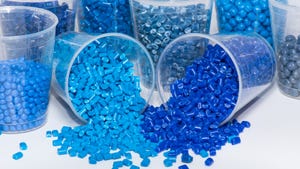The food that makes up your Thanksgiving feast? Much of it stays fresh longer and is pathogen-free because of extruded plastic film.
November 25, 2023

November is an easy month to write my column, as there is so much to be thankful for, including plastics, despite our myth-understanding detractors. They usually mean well, but often see plastics as toxic, corporations as greedy, and chemicals as evil and the opposite of natural. If I tell them that water is both, they can't believe this as they see them as opposites. Worse yet, I remind them we put chemicals into our tap water to make it drinkable.
I am a chemist with bio training, and see plastics as chemical compounds, much like our foods but indigestible. More detail? Ask me, but remember the need for humans to believe in the impossible.
The mechanical behavior of plastics
Tech talk this month is a reminder that temperature and molecular orientation control the mechanical behavior of plastics in service. That means knowing what molecules and atoms are, and how they are connected in a plastic, including the role of energy. No magic, no miracles, but it needs understanding and the denial of anything supernatural. Not so easy.
If you know how a molecule is built — linear, branched, co-monomer, energy in the atom-atom bonds — you can see why extruded samples will test differently from ASTM standard specimens. This can be used for positive or negative purposes, but my intent is positive: To avoid using such terms as stronger or tougher without numbers.
Know your motor and how to calculate energy from amps and rpm. This varies for different kinds of motors, so no one rule fits all. Then, if you know how much energy is needed to get a given weight of your plastic to the extrusion temperature, you can tell how much is coming from the motor, add a loss factor, and calculate how much more is needed from the heaters. And you'll see the energy cost to process, and help quantify the contribution of plastics to climate change.
It's Thanksgiving so let's be thankful for what we don’t have — no local wars or many, many types of disease, and for safe places to be in such cases. Sunny, low-wind days are a bonus here. Rain is coming and welcome, but I'm grateful either way.
Net benefit of extruded filaments
Extruded filaments and nets help us to catch fish, which feed so many on earth. I'm one of them but depend on the filament fisherfolk. Extruded pipe and film help us grow land-based food, and more film is used to protect the food from farm to tummy. It protects us from those hard-to-see tiny pathogens we too easily ignore in our reluctance to credit the plastic with protecting us and admit that the pathogens exist. The medical world uses what works best, relatively unrestrained by cost.
Damp and leaky homes are rare because of extruded roofing bases and house wrap, and miles of insulated wire help us live modern lives with electric light and heat. These are among the permanent uses of plastics ignored by those who stress the disposables.
And the compounders who make and sell the formulations deserve our thanks, as well.
Is recycling better for the environment? Not always, as it can use more energy than it saves. Most plastic bags don't have to be single use, but get to be so if there is a tosser — someone who doesn't wash the baggies and tosses trays and bottles into the garbage. As a war kid, I learned that pride in saving/reusing was more acceptable than the illusion of affluence shown by the tossers.
I'm thankful for the whole manufacturing chain, of course, including the office people and especially the line workers, who show up to keep the extruders running, and the warehousers who keep the stuff moving.
And thanks to the buyers who resist plastophobia and can see advantages or savings or performance using the pipe and tubing, film and sheet, wire and fibers that we make.
About the Author(s)
You May Also Like




